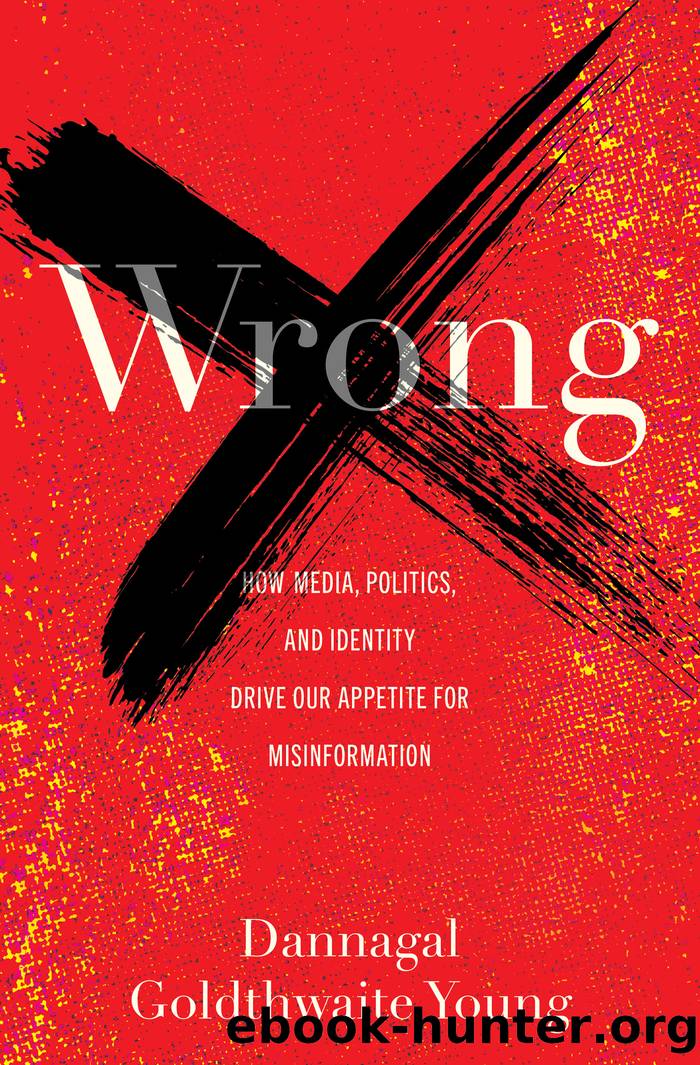Wrong by Dannagal Goldthwaite Young

Author:Dannagal Goldthwaite Young [Young, Dannagal Goldthwaite]
Language: eng
Format: epub
Publisher: Johns Hopkins University Press
Published: 2023-10-15T00:00:00+00:00
Reinforcement in a High-Choice Media Environment: A Different Beast
As cable fragmented the television landscape in the 1980s and 1990s, cultivation research moved in a new direction. With more thematically diverse viewing options, it became harder to argue that all media content had the same effect on heavy television viewers.11 Instead, researchers began thinking about how exposure to specific media genres or programs was shaping viewersâ perceptions of reality. This approach centered on how mediated depictions of the world (of events, relationships, and power dynamics) shaped the cognitive representations (mental models) viewers came to hold in their minds.12 Watching shows that depicted traditional romantic relationships, for example, informed our brainâs schematic representations of what âromantic relationships look like.â13 We would then draw on those âmental modelsâ to make sense of the real world.14 In other words, exposure to specific media content served as an âobservation of the worldâ that we then used to inform our knowledge, theories, and beliefs about what reality was like.
On average, media provide just some of the many observations that we use to understand our worlds. This helps explain why the strongest media âeffectsâ tend to emerge in the context of issues and topics with which we have the least real-world experience.15 Researchers have found that the effects of watching stereotypical depictions of minority groups on television are strongest among those with little interaction with members of those groups in real life.16 Similarly, the effects of media exposure on perceptions of police are greatest for those with the fewest real-world interactions with police.17 If media provide some fraction of the observations that we use to inform our understanding of the world, then mediaâs influence will be strongest in the context of phenomena we have the least opportunity to directly âobserveâ on our own.
Putting this all together, from the 1960s to the 1980s, centralized low-choice media technologies were operating against the backdrop of low elite polarization, high(ish) trust in institutions, and sociodemographically mixed (not very sorted) political parties. In their quest to offend as few people as possible, media producers created broadly appealing, status-quo-affirming television content that was associated with viewers looking more and more similar in their worldviews the more they watched.
But what happens in a decentralized, high-choice, fragmented media environment in which media producers deliberately create content to separateâand create relationships withâdifferent kinds of people? And what happens when this strategic audience segmentation occurs in a climate of increasing political polarization, institutional distrust, and the social sorting of the political parties? Well, the fact that MSNBC, Fox News Channel, and the political news satire program The Daily Show were all launched in 1996 is no accident. Recall that the 1994 Republican revolution marked a seismic shift in American politics. It coincided with a sharp increase in ideological polarization of elites, increased affective polarization among the public, and the increased social sorting of the two parties. All these trends were making American media consumers harder to please, especially in terms of their perception of bias in political programming.
Download
This site does not store any files on its server. We only index and link to content provided by other sites. Please contact the content providers to delete copyright contents if any and email us, we'll remove relevant links or contents immediately.
| Anarchism | Communism & Socialism |
| Conservatism & Liberalism | Democracy |
| Fascism | Libertarianism |
| Nationalism | Radicalism |
| Utopian |
The Secret History by Donna Tartt(18694)
The Social Justice Warrior Handbook by Lisa De Pasquale(12069)
Thirteen Reasons Why by Jay Asher(8716)
This Is How You Lose Her by Junot Diaz(6689)
Weapons of Math Destruction by Cathy O'Neil(6068)
Zero to One by Peter Thiel(5618)
Beartown by Fredrik Backman(5533)
The Myth of the Strong Leader by Archie Brown(5358)
The Fire Next Time by James Baldwin(5185)
How Democracies Die by Steven Levitsky & Daniel Ziblatt(5083)
Promise Me, Dad by Joe Biden(5029)
Stone's Rules by Roger Stone(4981)
100 Deadly Skills by Clint Emerson(4785)
A Higher Loyalty: Truth, Lies, and Leadership by James Comey(4768)
Rise and Kill First by Ronen Bergman(4643)
Secrecy World by Jake Bernstein(4584)
The David Icke Guide to the Global Conspiracy (and how to end it) by David Icke(4539)
The Farm by Tom Rob Smith(4397)
The Doomsday Machine by Daniel Ellsberg(4366)
